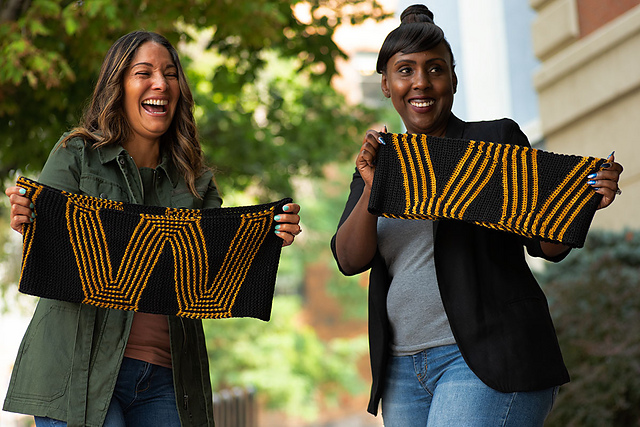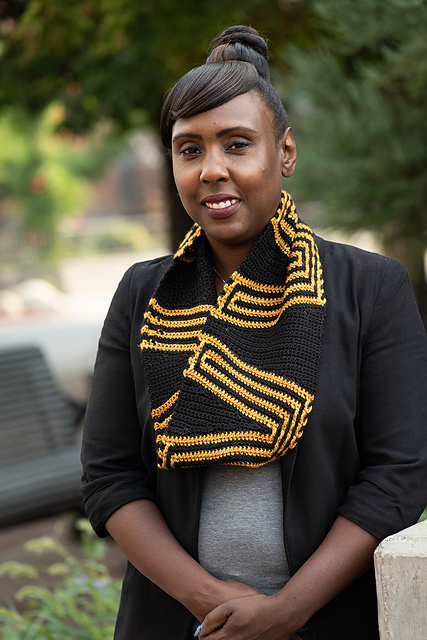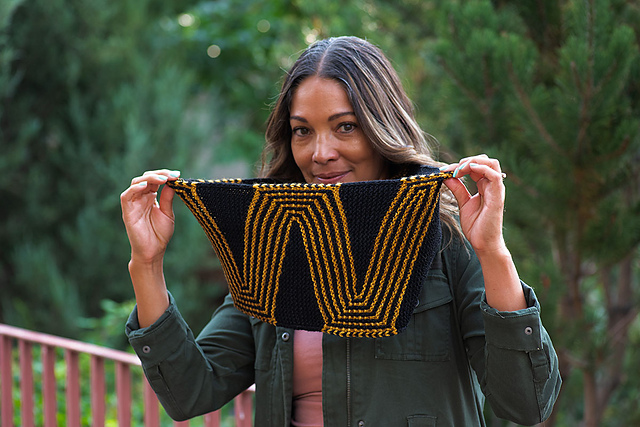When I saw the Wonder Woman Cowl, knit and crochet, I wanted to find out more about their creation, so I asked Carissa Browning if she’d let me interview her, and she said yes! (I love it when people do that 😉
I see that this is not your first knit/crochet twin project, you’ve also got the Wonder Woman Wrap, and the Yip Yips. Was your design process different in any of these designs?
Although I began as a crocheter, I feel I took to knitting more naturally, and dare I say obsessively. When developing a new design, I often envision it in knitted stitches initially and then, if there seems to be enough interest, I’ll translate it into crochet. This was the order of operations for the Wonder Woman Wrap, the WW Cowl, and the Dissent Cowl too. However, sometimes an idea just seems better suited to crochet, which was the case with the Yip Yips. I wanted them to be sturdy but squishy, with a good bit of nubby texture too. It was only after making a crochet prototype that I began to ponder how it would look in a knitted fabric.
I like the way you paired garter stitch with single crochet (I can’t figure out from the photos exactly what you did in the turns of the W, but it looks great.) Are there other stitches you like to pair up from knitting and crochet?
Yes, the WW Cowl is worked in either garter stitch or single crochet, with the perpendicular stripes at each bend of the Ws being created with mosaic knitting or mosaic crochet. For the Wonder Woman Wrap, I matched garter stitch with half double crochet instead, worked at a looser gauge to give the shawl more drape. The Yip Yips are made of single crochet or stockinette stitch (though I’ve seen one knitter who used seed stitch instead to fantastic effect). The two versions of the Dissent Cowl are more fraternal twins than identical. There I chose to design the crochet cowl from scratch, taking advantage of crocheted linen stitch, post stitches, and puffs, rather than try to replicate the mosaic knitting of the original sample.
Did you use a finer yarn for the crochet version than the knit version?
No, in each of my “twin” patterns, I’ve used the same weight yarn for both versions. Of course, crochet usually requires a bit more yardage than knitting does.
Was it hard to find a colorway that was solid enough for the letters to be distinct?
It wasn’t difficult at all, actually. For a pattern like this, I think the key is having enough contrast between the two colorways, and worrying less about variations within each colorway. For the WW Cowls, I chose two semi-solid/tonal yarns with subtle color changes throughout. However, there is still significant contrast between the darkest bits of the gold and the lightest areas of the black that the stripes still stand out nicely. One of my testers paired a solid black with a pastel variegated, and another used solid white with a dark blue/green/black variegated. Both were stunning! I would recommend though, if you do want to use a variegated, to make it the background color and pick a solid color for the letters.
Did you have yarn samples in person?
I picked out several potential pairings from the website and asked my contact at Jimmy Beans Wool for her recommendations. Since she was able to look at the colors in person, she helped me narrow down my choices. Together we settled on Onyx for the black, and she sent me two different gold options to swatch and pick my favorite.
How was designing for an exclusive kit for Jimmy Beans Wool different from working with a magazine or self publishing?
The process was a bit more relaxed with Jimmy Beans Wool than I’ve experienced with print publications. We exchanged several emails discussing a few of my design ideas, yarn bases and colors, timeline, compensation, and such as that. Most big publishers require a more solid proposal upfront, detailed legal contracts, clear-cut deadlines, etc. Obviously self-publishing can be even more relaxed or even more rigorous depending on your boss (yourself). Each method has its merits and drawbacks, of course.
What feedback have you heard from your customers about your patterns that you have designed in two techniques?
Overall, it’s been very positive. I think everyone appreciates being included. The first couple times, I released a design as a knitting pattern and was almost immediately inundated with messages and comments from crocheters lamenting their inability to knit. So I would set about writing a matching crochet pattern for them. Now, I’m developing a better sense of which designs have potential for cross-craft popularity so I can preemptively create both versions for simultaneous release. Something I find incredibly interesting are the notes from my fellow bi-stitchual crafters saying “I mostly knit, but I actually like the crochet version of this pattern better” or vice versa. I must admit, I usually have a favorite myself too. 😉



